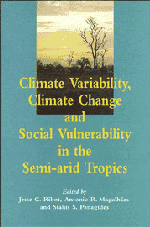Book contents
- Frontmatter
- Contents
- List of contributors
- Foreword by Tom Downing
- Preface
- List of abbreviations
- Introduction. Climate Variability, Climate Change and Vulnerability: Moving Forward by Looking Back
- PART I OVERVIEW
- PART II CLIMATE VARIATION, CLIMATE CHANGE AND SOCIETY
- PART III CLIMATE VARIABILITY AND VULNERABILITY: CAUSALITY AND RESPONSE
- PART IV THE INTERNATIONAL CONFERENCE ON THE IMPACTS OF CLIMATIC VARIATIONS AND SUSTAINABLE DEVELOPMENT IN SEMI-ARID REGIONS (ICID)
- 9 Declaration of Fortaleza
10 - Highlights of Working Group Discussions and Recommendations
Published online by Cambridge University Press: 02 December 2009
- Frontmatter
- Contents
- List of contributors
- Foreword by Tom Downing
- Preface
- List of abbreviations
- Introduction. Climate Variability, Climate Change and Vulnerability: Moving Forward by Looking Back
- PART I OVERVIEW
- PART II CLIMATE VARIATION, CLIMATE CHANGE AND SOCIETY
- PART III CLIMATE VARIABILITY AND VULNERABILITY: CAUSALITY AND RESPONSE
- PART IV THE INTERNATIONAL CONFERENCE ON THE IMPACTS OF CLIMATIC VARIATIONS AND SUSTAINABLE DEVELOPMENT IN SEMI-ARID REGIONS (ICID)
- 9 Declaration of Fortaleza
Summary
CRITICAL ISSUES AND NEEDS OF SEMIARID REGIONS
Climate variability and climate change
Semi-arid regions exist in the tropical, sub tropical and temperate zones of the earth. Their most prominent common characteristic is a lack of sufficient, reliable and timely rainfall. They experience wide variations in seasonal and annual precipitation. Droughts occur periodically. In recent years, scientists have made encouraging progress in predicting seasonal to inter-annual variability of precipitation in these critical zones, particularly in the tropics. At other times, extreme climatic variability may result in flooding. Under past and current conditions semi-arid regions have been climatic risk zones. A number of factors compound this natural vulnerability.
An increase in population and more intensive human activities, as has been experienced in many semi-arid regions, leads to increased stress on fragile or scarce resources, such as water, soil and wildlife. In many areas the population is in excess of the ecological carrying capacity under the current systems of economic production and resource use.
Many semi-arid regions are in developing countries and suffer from a high incidence of poverty, underemployment, poor health and illiteracy. Public infrastructure is often deficient, including roads, water resources, industry and housing. Economically and politically, rural populations often are powerless. The combination of climatic and social stress increases the vulnerability of the natural and human systems of semi-arid regions.
The regional consequences of global warming cannot yet be predicted with precision and confidence. But some impacts are probable. Increases in temperature will lead to increased evapotranspiration. This will be an important factor in places where the climate is hot under current conditions.
- Type
- Chapter
- Information
- Climate Variability, Climate Change and Social Vulnerability in the Semi-arid Tropics , pp. 170 - 175Publisher: Cambridge University PressPrint publication year: 1996



